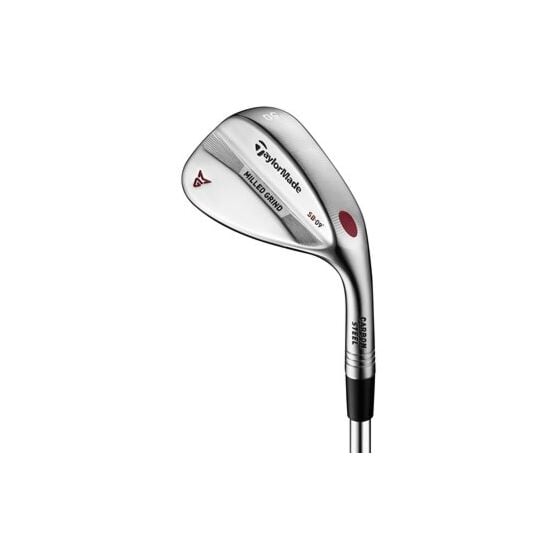-
{{link.label}}{{link.label}}
What's the Difference between Used & New Golf Wedges
On this page
Wedges are a key part of your club set. Their versatility allows them to be useful from both short and long range. Whether you’re hitting a chip, pitch or going full send, they’ll serve you well, IF they’re in proper condition. And this is “IF” can be the difference maker on the course, which is why the results from this condition comparison test might be shocking to some readers!
At Golf Avenue, we pride ourselves on the quality of our used products, this is why each golf club, including our low-priced used wedges, is rated on a scale ranging from the highest-rated “New Condition” to the lowest-rated (and very rare) “Fair Condition”. Each condition comes with a different price tag that reflects its rating.
The differences between these conditions are usually easy to see to most, but in terms of performance, it can be difficult to tell one apart from just from looking at pictures. To help you better understand how much of a difference in performance there is from one condition to the next, we conducted a test where we compared the performance of 5 wedges, from our 5 condition rankings.
In this test, we compared the clubs using our Trackman-powered simulator. We took full swings with our clubs to have consistent comparison basis. We don’t have access to swing robots like the good people at MyGolfSpy, but we look to produce swing speed that we’re relatively similar from one club to the next. We will address the cases where you’ll see major discrepancies. Enough with the setup, let’s get into this one!
What wedge models did we choose for this test?
You’re probably burning to know which wedge model we used, and honestly, we weren’t too sure ourselves originally as its pretty rare that you’ll find a club available in all 5 conditions. At first, we even thought about using drivers, but we wanted to start with a club type that is easier to compare at lower swing speeds.

Fortunately, we were able to find the perfect candidate with the TaylorMade Milled Grind wedge. A high-quality value model that was featured in our list of the 5 best wedges from TaylorMade. We have plenty of those in stock, so we didn’t feel too bad taking 5 of them out of stock for a few days.
Club Specs: TaylorMade Milled Grind Satin Chrome Wedge, Right-handed, Wedge Flex, 56 degrees loft, 12 degrees bounce.
How do we rate our golf clubs?
Each golf club that comes through our doors is thoroughly inspected by our team of experts to guarantee its condition, whether that’s a trade-in you sent us or a return that wasn’t right for you. After an initial inspection, the club goes through a series of steps before its stored, waiting for you to pounce on deal.
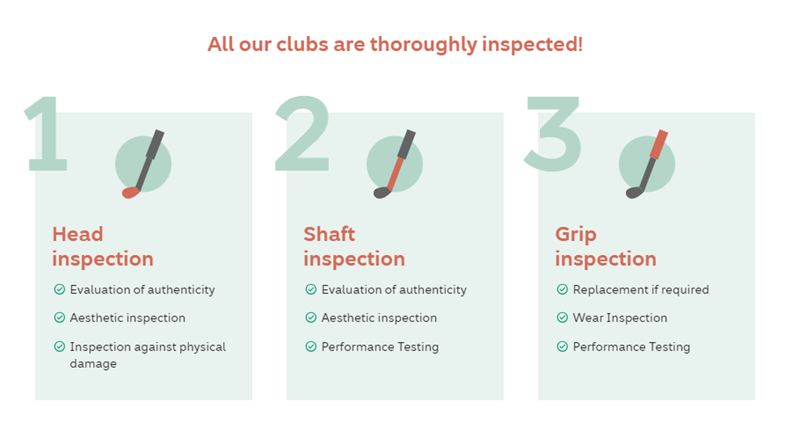
First, it goes through our micro-vibrations powered cleaning process. Then it moves on to our picture station, where we take 6 unique pictures of each club from different angles to give you the best look possible when you’re browsing for your next club. Finally, each club is closely looked at by our ratings squad who are task with establishing the ratings that will rank the clubs.
The rating squad reviews and rates each of the following five component (on a scale of 1 to 10) for every club: condition of the sole, the top/back of the clubhead, the club face, the grip, and the shaft. The sum of these ratings gives the club its condition ranking.
Golf Avenue Club Condition Rankings
As previously mentioned, the clubs on our website are offered in 5 different condition rankings, all proposing various price points for the different golfers out there. Additionally, each condition ranking has its own definition to help you understand how we differentiate between all of them.

New Condition
The items are brand new, in their original packaging.
Excellent Condition
The items are nearly impossible to differentiate from new. They have been used very few times, if at all, and show almost no wear.
Very Good Condition
Unlike our ‘New’ or ‘Excellent’ condition, these items have been used but are in fantastic shape. They may have a few scratches or show signs of wear if you look closely but still look like the newest items.
Good Condition
These items have seen normal use (usually several seasons) but are in better than average shape for that particular model. They may have some cosmetic imperfections but will look better than the average item.
Fair Condition
While we tend to not have a lot in stock, these items show clear mark of use, and may have seen better days, but they’re still to provide with loyal service, and for a very low cost!
Testing Criteria
We used two main criteria during this test to rank the performance of the clubs against one another. The first data point we focused on was Spin Rates, a critical aspect of any wedge’s performance, especially on the course. Then, we looked at total distance to see just how much power clubs may lose overtime and as their condition worsen.
We also looked at each club’s performance by taking more data points into account, like carry distance, swing and ball speeds, and more. We also did this to create a more complete picture of the performance of each of these clubs.
Performance Review
As previously mentioned, we took our clubs from the warehouse to our office, and we used our Trackman-powered simulator. We used about 10 strikes from each of the clubs we tested to create a performance average. Let’s first look at each of them individually.
Very Good Condition
Let’s first start right down the middle of our condition chart with our wedge rated “Very Good”.
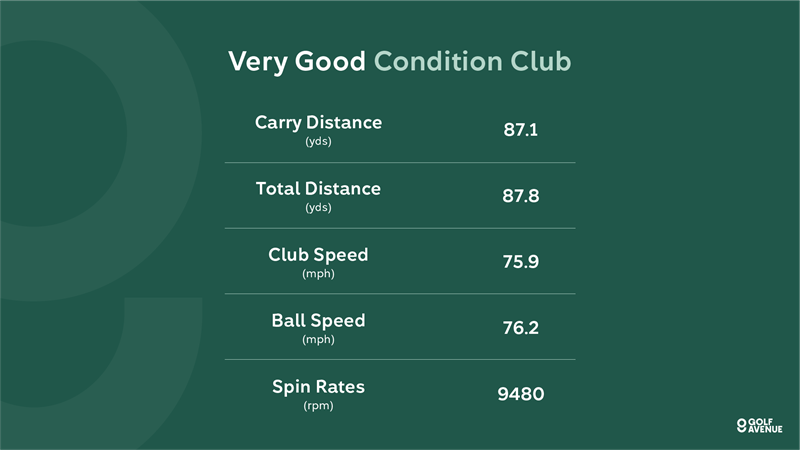
We appreciated the performance of the “very good” condition club and didn’t have anything out of the ordinary to report. The spin rates circled the 95-hundred mark, which is the mark we were aiming for during this test.
In terms of total distance and carry, the numbers are indicative of what we would expect from a 56-degree wedge with this kind of club and ball speeds. There’s minimal roll of the ball once it hits the ground as there is less than one yard of difference between the Carry and Total averages, a quality that most will want out of their wedges. The consistency is remarkable as the standard deviation on each data point is very low. Very impressive considering this a used wedge.
Excellent Condition
Second, we’re looking at the second-best condition ranking with the “excellent” condition wedge.
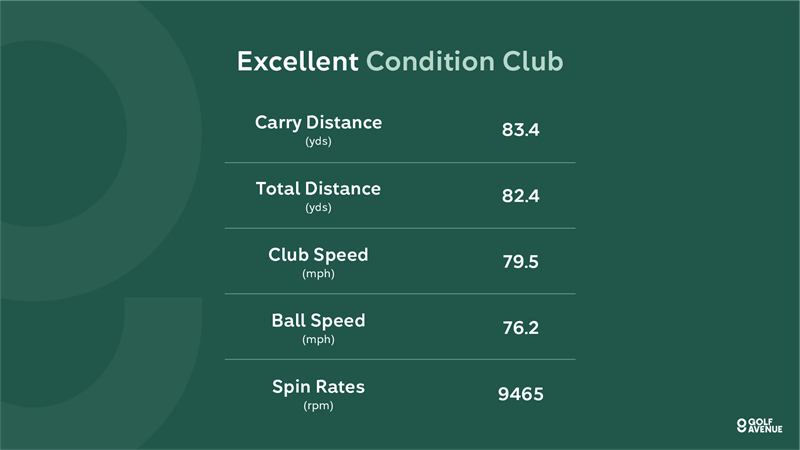
Here again, nothing major out of the ordinary, but that’s what you can expect from a golf club that was barely used. Carry and Total distance are probably the most eye-catching stats here as they’re 4 to 5 yards shorter than the “very good” model.
It needs to be said that the height of the strikes with the “excellent” club where higher, which explains the shorter strikes overall. BUT! The higher strikes also mean that the Total distance was shorter than the Carry as the spin rates were also nearing the 95-hundred mark. This means that the ball benefited from the sought-after “backspin” that we’re all trying to create. A yard of backspin is not massive, but it’s a testament to the stopping power of this almost brand-new golf club.
Good Condition
Next up, we’re going back down the rankings with the “good” condition club.
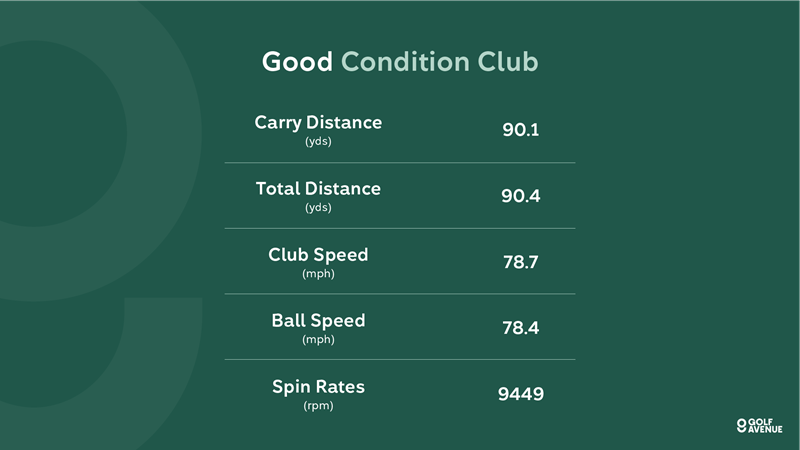
Once again, distances will catch the eye as they were the longest we had seen thus far. The reason is quite simple, the ball speed was the highest with this wedge at 78.4 MPH on average.
Spin wise, we were also in the same ballpark nearing the 95-hundred mark. The stopping power is not as great on with this one as we’re not getting the backspin, but it’s nothing to scuff at considering how small the difference is between the carry and total distance.
New Condition
Up next, we’re going at the top of the condition rankings with our “new” condition wedge.

Right away, we notice that none of the data points are jumping out to us. That’s simply because the numbers are just not that different from the used clubs. The Spin Rate is identical to the “excellent” condition club, but it doesn’t provide the highest spin level of all the clubs in this test.
In terms of ball speed, it’s also very similar to the other clubs that we’ve tested so far aside from the good condition that was slightly hotter. Though it’s not showing us anything out of the ordinary, it needs to be said that the stopping power of this wedge was enough to generate a bit of back spin.
Fair Condition
Now, the club we’ve all been waiting for, let’s look at the performance of our fair condition club.
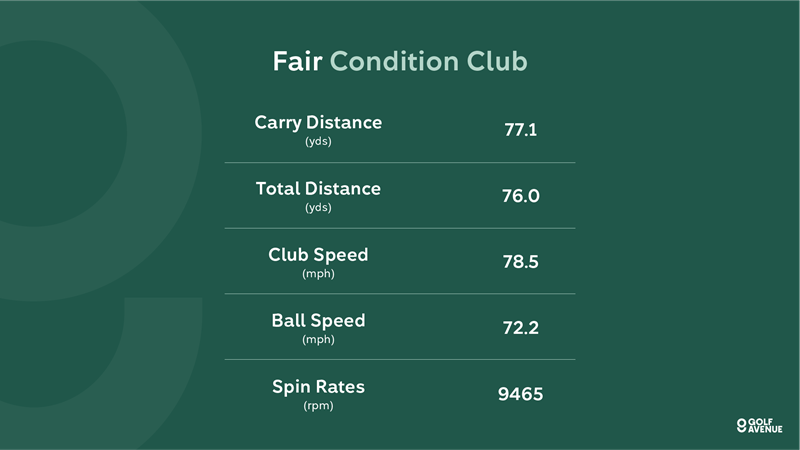
Right away, you’ll notice that the distance averages are both sitting in the mid to high 70’s, which is much lower than any of the other clubs we tested. The culprit for this can be identified with the ball speed, which is also considerably lower than the other clubs.
The data here seems to indicate that this wedge could be losing its “pop”. The club speed is in the same 78 MPH range as any of the other clubs we tested, so this could not be a simple explanation for the lower ball speed.
There are a couple of things that deserve our praise. Most notably the spin level which is the highest of all the clubs we tested. We originally thought that this was due to the nicks on the club face which probably helped make it more abrasive at impact, much like what happens with rusty finish on a wedge. But after testing the club once more during another session, we were not able to break the 93-hundred mark and the club was still struggling to break the 80 yds mark.
The high spin levels from our first session with this club led to a full yard of back spin during our test which is nothing to scuff at, but you have to ask yourself at this point is the loss in distance worth the extra spin?
Condition Comparison
After looking at each club’s individual performance, it’s to time to clearly see how they rank against each other using the two key data points we mentioned earlier: Spin Rates and Total Distance. We’ll use more data points to help put the rankings into context, but these will be our basis for rankings.
Let’s first look at spin rates. Our Trackman simulator spin rates are calculated based on revolutions per minute. Here’s what the ranking looks like:
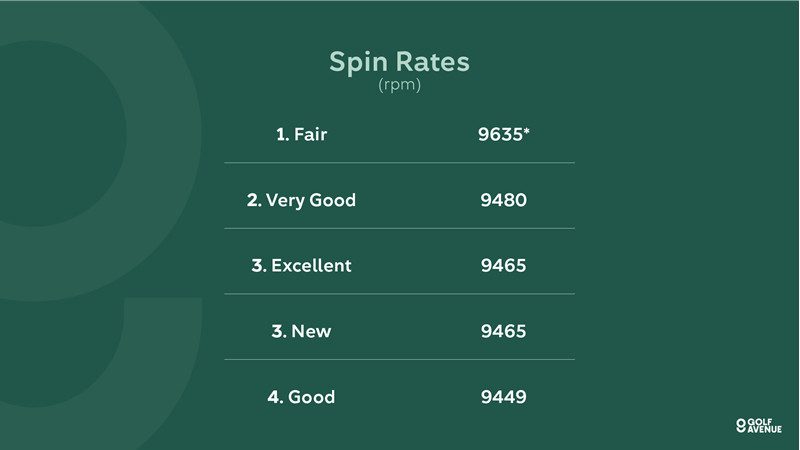
Our first test with the Fair condition club was probably an outstanding case as we were not able to reproduce such high spin rates in subsequent tests. But the most interesting fact we can take away from this ranking is that the condition of the club will most likely not affect the spin rates as the difference from one condition to the next is negligible.

Here again, we see a lower-end condition topping the chart. Of course, the ball speed has something to do with it in the case of the good and fair condition clubs, but the very good condition club sets itself apart from the new and the excellent with almost identical ball speeds.
In the case of the fair condition, it’s noticeably lagging the other clubs both in terms of distance and ball speed. This is odd because our average club speed with it was 78.5 MPH, much like it was with the good and new condition clubs at 78.7 and 78 MPH respectively. Which is why we believe that this club might be losing out on some of its “pop”.
Should you buy used wedges?
Now that we’ve reached the end of our test and that we’ve looked at each club’s individual performance on top of comparing them against one another, it’s time to answer the two questions we posed at the start.
First, we wanted to know the difference in performance levels from one condition to the next.
Based on what we noticed during our test, the used condition clubs, whether that’s good or even fair, can easily rival new or excellent condition clubs. This also means that unless you’re a highly skilled player looking to make the most out of their skills on the course, feel free to turn to used golf clubs, especially if you’re a beginner on a budget.
And while we conducted this test inside, it would be interesting to bring it outside to see the results. Additionally, it would be interesting to see how much of an impact the condition can have on shorter shot types like chips and pitches.
Finally, we wanted to see if new condition wedges are worth spending the extra dollars and if they’re a must for everyone.
Here again, our test shows that spending the extra dollars is not a must to get the performance you might be looking for. However, the performance of the fair condition club suggests that clubs that have seen a high volume of strikes over a long period of time can possibly lose out on a bit of their “pop” at impact. So going all out on a new golf club is not a must, but you should consider trying to secure a used golf club in the best condition possible.
Conclusion
This concludes our wedge condition comparison test. The results were certainly a bit unexpected for us, but what about you? If you want to do your own experiment at home, well now’s your chance. With Golf Avenue, you get to try your clubs at home for 30 days. Who knows, maybe you’ll get different results. And if this is the case, feel free to share them with us!
Until next time,
The Golf Avenue Team
Featured Products
Further reading
Here are the 8 best golf wedges under $100 from our expert selection. Find wedges from top brands like TaylorMade, Titleist, Cobra, and Callaway at Golf Avenue.
Get a golf wedge for your game with our buying guide. Learn the essentials when shopping for wedges and find the best models at affordable prices.

